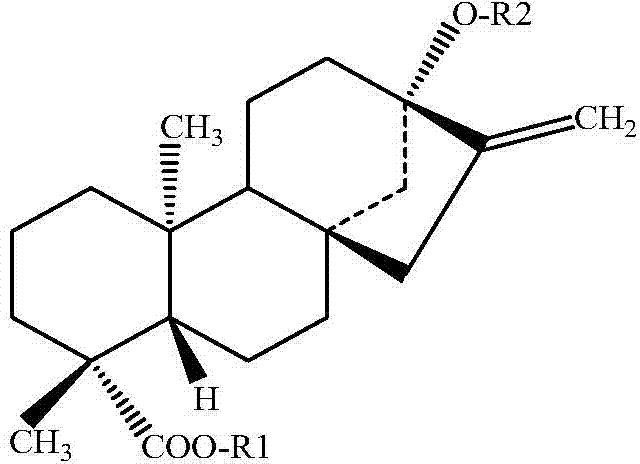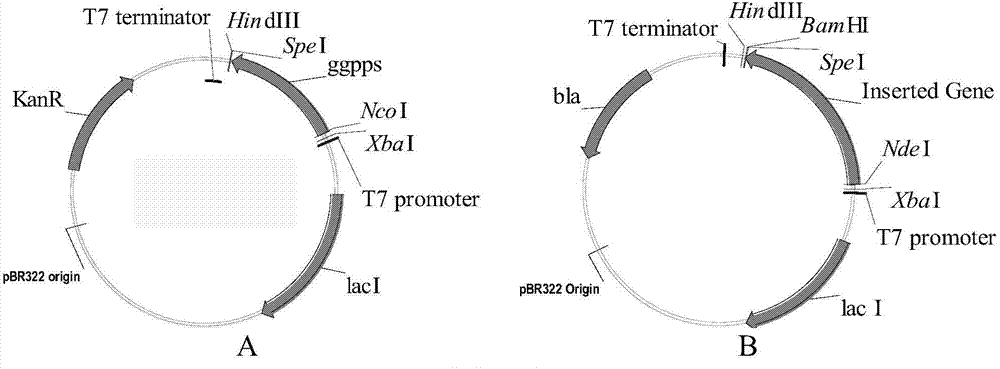Method for producing stevioside compounds by using microorganisms
A technology of steviol glycosides and compounds, applied in the field of synthetic biology
- Summary
- Abstract
- Description
- Claims
- Application Information
AI Technical Summary
Problems solved by technology
Method used
Image
Examples
Embodiment 1
[0203] Embodiment 1, Obtaining of proteins used in heterologous synthetic pathways of steviol glycoside compounds
[0204] Geranylgeranyl pyrophosphate synthase, Cuban pyrophosphate synthase, conchicene synthase, bifunctional conchicene synthase, conchicene oxidation Gene origin and synthesis of enzymes, conchiate-13α-hydroxylase, UGT85C2 glycosyltransferase, UGTB1 glycosyltransferase, UGT74G1 glycosyltransferase, UGT76G1 glycosyltransferase and cytochrome P450 redox proteins.
[0205] First, geranylgeranyl pyrophosphate synthase (GGPPS) from Canadian yew (Taxus canadensis) and stevia (Stevia rebaudiana) was selected from the National Bioinformatics Database (NCBI). Cuban pyrophosphate synthase (CDPS) from Stevia rebaudiana and Bradyrhizobium japonicum, shellene synthase (KS) from Stevia rebaudiana and Bradyrhizobium japonicum ), from Physcomitrella patens and Gibberella fujikuroi bifunctional conchene synthase (CPS / KS), from Stevia rebaudiana, Arabidopsis thaliana, Conchi...
Embodiment 2
[0242] Example 2 , Construction of prokaryotic expression vector
[0243] The geranylgeranyl pyrophosphate synthase, cubanpyrophosphate synthase, conchicene synthase, bifunctional conchicene synthase, conchicene oxidase, conchiolic acid-13α-hydroxy Clase, UGT85C2 glycosyltransferase, UGT74G1 glycosyltransferase, UGT76G1 glycosyltransferase and cytochrome P450 redox protein related genes were cloned into the corresponding plasmids, and the bacterial rebaudioside A synthesis pathway gene expression vector was cloned. Construct.
[0244] After the stop codon TAA of the optimized ggpps gene, a SpeI restriction site was added, and then it was cloned into the NcoI / HindIII restriction site of plasmid pET28a (purchased from Novagen) to obtain pET28a-ggpps ( image 3 A).
[0245] After the stop codon TAA of 9 genes of optimized cdps, cps / ks, ks, ko, kah, ugt85c2, ugtb1, ugt74g1, ugt76g1, SpeI sites were respectively added, and then these genes were respectively cloned into plasmid ...
Embodiment 3
[0258] Example 3 , Construction of fungal expression vector
[0259] The geranylgeranyl pyrophosphate synthase, cubanpyrophosphate synthase, conchicene synthase, bifunctional conchicene synthase, conchicene oxidase, conchiolic acid-13α-hydroxy Clase, UGT85C2 glycosyltransferase, UGTB1 glycosyltransferase, UGT74G1 glycosyltransferase, UGT76G1 glycosyltransferase and cytochrome P450 redox protein related genes were cloned into the corresponding plasmids, and fungal rebaudioside A Construction of synthetic gene expression plasmids.
[0260]First, the original pAO815 vector (purchased from Invitrogen) was transformed, and BamHI and XhoI restriction sites were introduced after the terminator of pAO815 by site-directed mutagenesis PCR. The transformed pAO815 was named pSY01. The BamHI site in the pET28a-ggpps gene was removed by site-directed mutagenesis PCR. The BglII site in the pET21a-ks gene was removed by site-directed mutagenesis PCR.
[0261] Using pET28a-ggpps as a temp...
PUM
 Login to View More
Login to View More Abstract
Description
Claims
Application Information
 Login to View More
Login to View More - R&D
- Intellectual Property
- Life Sciences
- Materials
- Tech Scout
- Unparalleled Data Quality
- Higher Quality Content
- 60% Fewer Hallucinations
Browse by: Latest US Patents, China's latest patents, Technical Efficacy Thesaurus, Application Domain, Technology Topic, Popular Technical Reports.
© 2025 PatSnap. All rights reserved.Legal|Privacy policy|Modern Slavery Act Transparency Statement|Sitemap|About US| Contact US: help@patsnap.com



